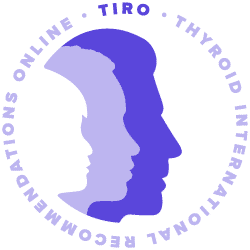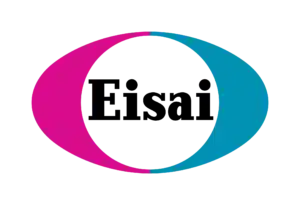Initial Staging & Treatment Planning
Clinical Outline
= Primers in Thyroidology
= Journal Club Presentation
= Case-based Discussion (inc. roundtables)
= Grand Rounds Lectureship
Management Recommendations
1. Multidisciplinary Care
ATC is a unique thyroid malignancy that requires expert care by a team of multidisciplinary specialists who are experienced in ATC management. It is imperative that comprehensive multidisciplinary engagement be achieved prior to defining the goals of care and discussing treatment options with the patient.1–4
It is important that patients have appropriate cognitive ability to understand and be able to consent to specific medical decisions that they are required to make. If there is any question as to the patient’s capabilities, then mental health assessment should be rapidly obtained along with input from individual(s) trained in medical ethics to assist in establishing a plan of care.1
2. Initial Staging of Patients with ATC Diagnosis
In the expedited evaluation of patients diagnosed with ATC, it is vital to determine the locoregional extent of disease as well as to identify the presence of spread outside the neck. Cross sectional imaging using contrast enhanced CT examinations (or MRI) of the neck, chest, abdomen and pelvis should be performed. FDG PET CT can provide useful information in staging. When indicated, an MRI of the brain should be considered.1–4
Other Diagnostic Studies
- CBC; a white cell count (> 10,000 is poor prognostic finding).1–4
- Liver function tests, BUN, creatinine, and glucose.1
- TSH, free thyroxine, thyroglobulin, and thyroglobulin antibody.1
A. Expedited Initial Evaluation is Essential
Due to the rapidity of the growth of ATC, it is essential that a coordinated and expeditious scheduling of appointments for scans and multidisciplinary assessment be achieved.1,2,4
The performance of cytologic or pathologic assessment of lesions outside the neck for possible metastatic spread provides important information for the overall plan of care. Some guidelines advocate that these biopsies be performed, however, not allowing such to delay the initiation of primary therapy.1 Other guidelines favor initial assessment of resectability prior to consideration of systemic therapy.3,4
Due to the invasive nature of ATC, treatment planning and, in particular surgical assessment, depends on an understanding of each patient’s vocal cord function and potential tracheal invasion. Over time, this may require repeat assessment during therapy as indicated by the patient’s evolving clinical symptoms.1–4

Add Upcoming TIROxMDS Seminars to Your Calendar
In 2 quick steps, you can add our entire schedule of upcoming seminars to your calendar today! Then you will get notified of upcoming lectures, presentations and case-based studies. Every Friday at 8:00 AM EST, we cover a new topic from published research.
Add to CalendarReferences
- 1.Haugen BR, Alexander EK, Bible KC, et al. 2015 American Thyroid Association Management Guidelines for Adult Patients with Thyroid Nodules and Differentiated Thyroid Cancer: The American Thyroid Association Guidelines Task Force on Thyroid Nodules and Differentiated Thyroid Cancer. Thyroid. Published online January 2016:1-133. doi:10.1089/thy.2015.0020
- 2.Haddad RI, Nasr C, Bischoff L, et al. NCCN Guidelines Insights: Thyroid Carcinoma, Version 2.2018. J Natl Compr Canc Netw. Published online December 2018:1429-1440. doi:10.6004/jnccn.2018.0089
- 3.Ito Y, Onoda N, Okamoto T. The revised clinical practice guidelines on the management of thyroid tumors by the Japan Associations of Endocrine Surgeons: Core questions and recommendations for treatments of thyroid cancer. Endocr J. Published online 2020:669-717. doi:10.1507/endocrj.ej20-0025
- 4.Filetti S, Durante C, Hartl D, et al. Thyroid cancer: ESMO Clinical Practice Guidelines for diagnosis, treatment and follow-up. Annals of Oncology. Published online December 2019:1856-1883. doi:10.1093/annonc/mdz400
- 1.Haugen BR, Alexander EK, Bible KC, et al. 2015 American Thyroid Association Management Guidelines for Adult Patients with Thyroid Nodules and Differentiated Thyroid Cancer: The American Thyroid Association Guidelines Task Force on Thyroid Nodules and Differentiated Thyroid Cancer. Thyroid. Published online January 2016:1-133. doi:10.1089/thy.2015.0020
- 2.Haddad RI, Nasr C, Bischoff L, et al. NCCN Guidelines Insights: Thyroid Carcinoma, Version 2.2018. J Natl Compr Canc Netw. Published online December 2018:1429-1440. doi:10.6004/jnccn.2018.0089
- 3.Ito Y, Onoda N, Okamoto T. The revised clinical practice guidelines on the management of thyroid tumors by the Japan Associations of Endocrine Surgeons: Core questions and recommendations for treatments of thyroid cancer. Endocr J. Published online 2020:669-717. doi:10.1507/endocrj.ej20-0025
- 4.Filetti S, Durante C, Hartl D, et al. Thyroid cancer: ESMO Clinical Practice Guidelines for diagnosis, treatment and follow-up. Annals of Oncology. Published online December 2019:1856-1883. doi:10.1093/annonc/mdz400






